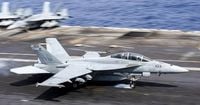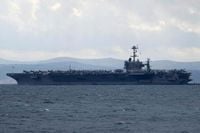On Tuesday, May 6, 2025, an F/A-18F Super Hornet assigned to the USS Harry S. Truman (CVN-75) went overboard during an attempted landing on the aircraft carrier in the Red Sea. The incident occurred around 9:45 p.m. local time, marking the second time in just over a week that a fighter jet has been lost from the Truman. The aircraft, part of the "Red Rippers" of Strike Fighter Squadron (VFA) 11, failed to catch the arresting wire, a crucial component in carrier landings designed to halt the aircraft's momentum.
According to a defense official who spoke to USNI News, both aviators aboard the Super Hornet safely ejected and were rescued by a helicopter from Helicopter Sea Combat Squadron 11. They were evaluated by medical personnel and found to have only minor injuries. Fortunately, no flight deck personnel were injured during the incident.
This mishap is the latest in a series of troubling events for the Truman, which has been actively involved in airstrike operations against Yemen's Houthi rebels. In fact, just a week prior, another single-seat Super Hornet from the "Knighthawks" of Strike Fighter Squadron (VFA) 136 fell off an aircraft elevator into the sea after the carrier made an evasive maneuver to avoid a suspected Houthi attack.
In December 2024, the Red Rippers lost another Super Hornet due to a friendly fire incident involving a missile from the USS Gettysburg (CG-64). The Truman has also faced operational challenges, including a collision with a merchant vessel earlier this year, which resulted in the removal of the ship's then-commander, Captain Dave Snowden. He was replaced by Captain Christopher Hill.
As of Tuesday evening, the Truman remains fully operational despite these setbacks. The carrier, along with its embarked Carrier Air Wing One, has been deployed from Norfolk since September 23, 2024, and its deployment was recently extended by a week.
The ongoing operations have been intensified since March 15, 2025, when Carrier Air Wing 1 began conducting strikes on Houthi targets in Yemen as part of Operation Rough Rider. On the same day as the recent incident, President Donald Trump announced that the U.S. would halt strikes against the Houthis, coinciding with claims from Oman’s foreign minister that a ceasefire had been reached with the rebel group.
However, the Houthis have continued to launch drone and missile attacks against commercial and military vessels in the Red Sea, raising concerns about the security of this vital shipping corridor. From November 2023 to January 2025, the Houthis targeted over 100 merchant vessels, sinking two and resulting in the deaths of four sailors. This aggressive campaign has significantly disrupted trade in an area that typically sees about $1 trillion worth of goods move annually.
Despite the announcement of a ceasefire, reports indicate that the Houthis fired upon the Truman shortly after the ceasefire was declared, highlighting the precarious nature of the situation. The ongoing conflict has drawn attention from senior U.S. military leaders, with Defense Secretary Pete Hegseth extending the Truman's deployment multiple times to ensure adequate naval presence in the region.
As investigations into the recent mishaps continue, the Navy is under scrutiny regarding the operational strain placed on the Truman's crew amid ongoing hostilities. The repeated incidents involving the loss of fighter jets have raised questions about the effectiveness of training and operational protocols.
The Truman's deployment has been marked by significant challenges, including the need for emergency repairs following its collision with a merchant vessel. The carrier has been actively engaged in the U.S. military's response to Houthi aggression, which has escalated since the Biden administration began launching strikes against the militants in early 2024.
As the situation unfolds, the Navy is expected to conduct thorough investigations into the recent incidents, including the arrestment failures that led to the loss of two fighter jets within a week. The results of these inquiries may lead to changes in operational procedures as the U.S. military continues to navigate the complexities of the conflict in the region.
While the recent events have not resulted in fatalities among service members, they underscore the ongoing risks faced by military personnel operating in high-stakes environments. The Truman, a crucial asset in the U.S. naval fleet, has been at the forefront of efforts to stabilize the region amid escalating tensions with the Houthis.
As the U.S. military reevaluates its strategy and operational readiness, the focus will remain on ensuring the safety of its personnel and the effectiveness of its missions in the face of persistent challenges.





